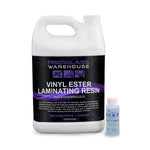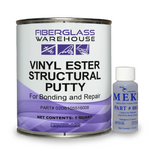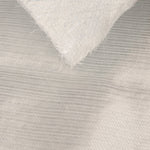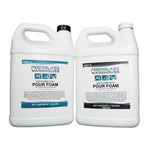You have no items in your shopping cart.
Do you have a project in mind but have no idea where to start? Let us help you. One of the first things you will want to do is decide what kind of fiberglass you want to use. Do you need to build up thickness fast? Are you concerned about strength? Do you have tight corners you are working with? Let us break things down a bit to help you decide if fiberglass cloth is right for your project or if you are needing chopped strand mat. Keep in mind that you can actually use both together to achieve your desired outcome. Below is an overview.
Fiberglass Cloth

(Plain weave fiberglass cloth)
Fiberglass Cloth is a woven fabric. Plain, 4 harness satin and 8 harness satin are the weave styles we carry. The 4, 6 and 10 ounce plain weave fabrics are the most commonly used. In this simple plain weave pattern, warp and fill yarns are interlaced over and under each other in alternating fashion. The plain weave is the easiest to handle since it does not unravel as much as the other weaves when cut.

In the four-harness satin weave pattern there is a three by one interfacing where a filling yarn floats over three warp yarns and under one.

The eight harness satin is similar to the four harness satin except that one filling yarn floats over seven warp yarns and under one. The satin weaves are slightly stronger and more pliable than the plain weave and are easier to conform to curved surfaces. They are more difficult to handle than the plain weave, though. Use fiberglass cloth when you are looking to create a strong, light weight product.

Chopped Strand Mat
Chopped Strand Mat (also known as fiberglass mat) has short strands of fibers held together with a resin binder. The fibers are randomly oriented. Mat is only compatible with polyester and vinyl ester resin. When resin is added to the mat, the binder dissolves and the fibers can be moved around. It is easier to conform mat to tight curves and corners than it is with weaved fabric. The reason chopped strand mat is not compatible with epoxy resin is because the binder holding the fibers together needs styrene to properly dissolve. Polyester and vinyl ester resins have styrene in them. (There are some places that sell chopped strand mat that is compatible with epoxy but it is hard to come by and much more expensive). Chopped strand mat is the least expensive fiberglass and is often used in mold construction or projects where thickness is needed. Mat is often used as the first layer (before the gelcoat) in a laminate to prevent print through. Print through is when the fabric weave texture shows through the resin. Chopped Strand mat does not have much strength. If you need strength you should choose a woven cloth or you could mix the two. Mat can be used between layers of woven fabric to help build thickness quickly and aid in all layers bonding well together.
For info on more fiberglass reinforcements and resin, check out our Ultimate Fiberglass and Resin Guidebook for Beginners.
For more detailed information on each fiberglass cloth we carry, you can CLICK HERE.
comments (57)
-

-
 Edward Atha
Edward AthaI’m building a large vivarium and want to fiberglass it rather then paint it the cage dimensions are 70″ W x 24″ D x 48″ H it’s my first time to use fiber glass any help much appreciated.
REPLY from fgwarehouse: Is the frame going to be made with plywood, then cover the plywood with fiberglass and resin?
-
 chhana
chhanaCan i do vaccum infusion process with fiberglass cloth
REPLY from fgwarehouse: Yes you can.
-
 Matt
MattI want to install a skylight on a campervan that has a fibreglass roof. I am going to bolt the framework to the roof supports but need to build fibreglass up the sides to keep the water out and provide some strength. Do I need to use cloth or will strand mat do the trick?
REPLY from fgwarehouse: Epoxy will do the best adhering to the framework. So you will need to use fiberglass cloth, like the 6 oz Style 3733. If you don’t want to go with the expense of the epoxy/cloth. Vinyl Ester resin is the next best resin. It is almost as waterproof as the epoxy. And you can use chopped strand mat. You can also use Orca 301 ISO resin with good results also. With the vinyl ester and ISO resins, you can use gel coat over top of it. The gel coat is UV protected. The epoxy should be painted over with a UV protected polyurethane paint.
-
 Mark
MarkHello,
I need to reinforce an area on an old jet ski that is SMC. What would be the preferred fiberglass and I’m assuming epoxy resin only? Also what type of prep would need to be done before applying the fiberglass. Thanks for your help.
REPLY from fgwarehouse: I would go with epoxy. Our 1200 2:1 epoxy will do great. If the fiberglass is cracked, you should try and grind out the broken part, the layer in fiberglass afterwards. I would probably use 6 oz fiberglass cloth, style 3733. It is a smooth fiberglass.










I want to repair my swimming pool in ground what kind of fiberglass mat I have to use how much fiberglass mat I need in my swimming pool in ground 35″5″ length ×15″8″width 37″shallow 6″4″deep thanks.
REPLY from fgwarehouse: Hello Mario, I calculated roughly 122 square yards that you will need. First off, what is the problem? Are you just redoing the surface? Is the surface cracked? Is the gel coat peeling? You will also need to choose a type of resin. You need a minimum of ISO resin and our guard gel coat.
REPLY from Mario r Miralda: hi yes I want to redoing the surface and floor it has holes in the walls floor is cracks thank you for your help